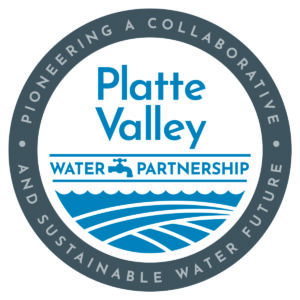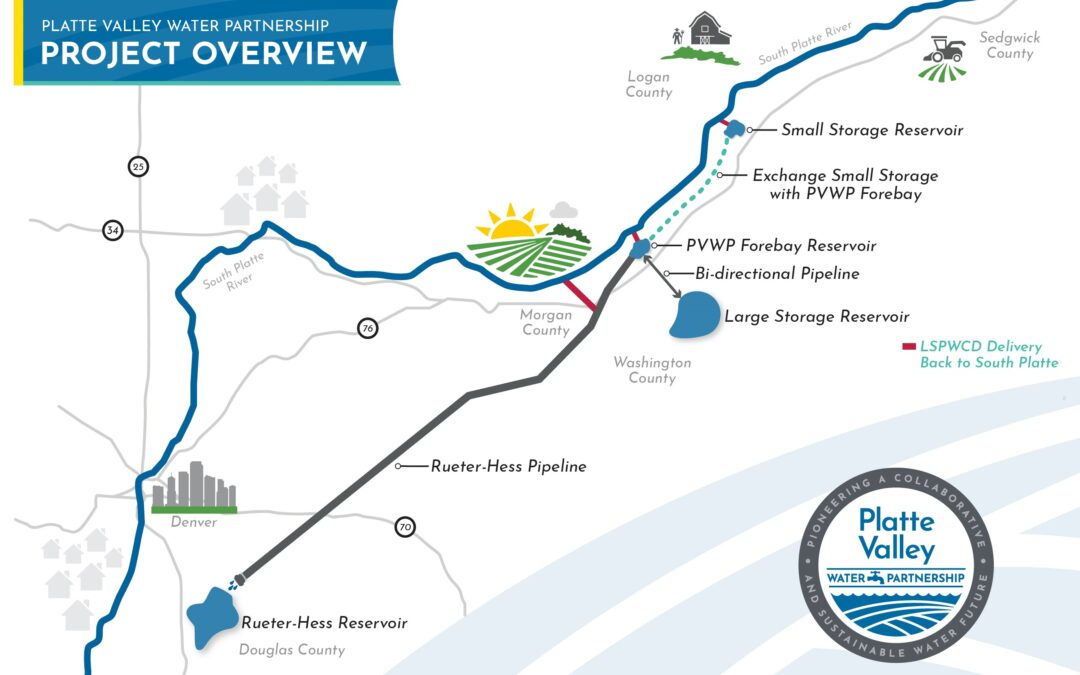We recently sat down with representatives from Parker Water and Sanitation District—sponsors of the latest issue of Headwaters magazine—to learn more about the Platte Valley Water Partnership (PVWP), a collaborative and forward-looking water supply initiative.
How did the Platte Valley Water Partnership come into being?
After about a decade of working together as members of the Northeast Colorado Water Cooperative (NECWC), Joe Frank, General Manager of the Lower South Platte Water Conservation District, and Jim Yahn, General Manager of Prewitt Reservoir, approached Parker Water and Sanitation District (Parker Water) with this idea. They proposed that instead of drying up the farms Parker Water owns in Northeast Colorado, we would file jointly for a junior water right on the South Platte River with the Lower South Platte Water Conservancy District (Lower South Platte), with the intent of developing a project that would benefit agricultural and municipalities, without buy-and-dry. Parker Water bought into the idea.
 Our goal for the project is to not only “do no harm” to the community but to actually bring more to the community. That was the philosophy that guided the creation of the Platte Valley Water Partnership, and in fact the commitment to not allowing water that is buy-and-dry to be used by any of the project’s shared infrastructure.
Our goal for the project is to not only “do no harm” to the community but to actually bring more to the community. That was the philosophy that guided the creation of the Platte Valley Water Partnership, and in fact the commitment to not allowing water that is buy-and-dry to be used by any of the project’s shared infrastructure.
How much of the water from this project will be allocated to agricultural use?
The partnership between Parker Water and the Lower South Platte Water Conservancy District states that fifty percent of the diverted water is for the benefit of agriculture. For example, if 250 cubic feet per second (cfs) is diverted, then 125 cfs is the Lower South Platte’s and 125 cfs is Parker Water’s. There is an opportunity for the Lower South Platte to lease a portion of their 50% to Parker Water to help offset project costs for them. There is also the opportunity for Parker Water to lease a portion of their share to the Lower South Platte when they need it. For example, when it is a dry year Parker Water can lease to the Lower South Platte and then in the wet years the Lower South Platte can lease to Parker Water.
The first PVWP-related land purchase was finalized in Morgan County in November 2023. Has construction begun on the forebay (small reservoir) yet or do you have a timeline in mind?
It was very fortuitous to find the property in Morgan County which is near two of the projects identified alternate points of diversion and a possible forebay location. Our overall goal is to target 2040 for the project to be fully online. Currently, we are in the water court process. Once the rights have been resolved, we will start the permitting and design process. We will then move into the construction phase around 2030-2035 depending how we phase the project.
Castle Rock Water officially joined the partnership in October 2024. How do they fit into the overall project plan?
Castle Rock has filed for a separate 2021 junior water right on the South Platte River. They have joined the partnership and will make use of the project infrastructure in order to deliver their water rights to Castle Rock. By bringing on an additional participant, we are able to help lower the costs for each of us individually.
The 2019 water rights application for this project is still making its way through Water Court, with an August 2025 adjudication date set for the junior water rights. How is the team preparing for that milestone?
Due to an unexpected illness in a valued team member, we have had to reschedule (known as a continuance) our August 2025 trial date. This was an unopposed motion to continue (100% supported), and we anticipate being given a new court date soon. In the meantime, we are working diligently to meet with all opposers to try and reach settlement agreements and narrow any issues if we do need to go to trial.
Rueter-Hess Reservoir is slated to be used for PVWP water storage. How is the partnership balancing that operational use with the reservoir’s recreational benefits?
The increased water in Rueter-Hess Reservoir should not have much impact on recreational activities. Currently, the reservoir is open to the public four days a week for fishing, paddle boarding, kayaking, and hiking. We anticipate that all of those activities will continue, regardless of an increase in water levels.
“We are really trying to set an example for the future of municipalities- that you don’t have to buy and dry. There can be a future for both agriculture and urban water use”. -Heather Justus
The Platte Valley Water Partnership was a sponsor for the summer 2025 issue of Headwaters magazine focused on groundwater. View the summer 2025 issue here.


 Print
Print